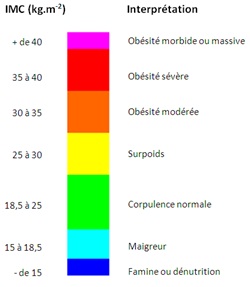BMI or Body Mass Index
 BMI, body mass index (BMI or English), determines the size of a person. It is the World Health Organization (WHO) has defined this index to assess the risks associated with overweight. It is calculated according to weight and size.
BMI, body mass index (BMI or English), determines the size of a person. It is the World Health Organization (WHO) has defined this index to assess the risks associated with overweight. It is calculated according to weight and size.
Interest
This index is particularly useful to highlight the increased risk factors due to excess (or lack) of weight. Indeed, it was observed that an increase in deaths from cardiovascular disease, cancer, diabetes (...) progressively with the increase in BMI.
The formula
BMI = Weight (kg) / height (m) 2 Click here to calculate your BMI
Interpretation
The standard intervals (underweight, normal index, overweight, obesity) have been defined by WHO, based on statistically proven relationship between BMI and mortality.
BMI (kg.m-2) Interpretation
40 + Morbid obesity or massive
From 35 to 40 Severe obesity
From 30 to 35 Moderately obese
25-30 Overweight
18.5 to 25 Normal Build
15 to 18.5 Underweight
- 15-Famine and malnutrition
One should nevertheless be careful, BMI is an indicator. It does not take into account the proportion of muscle mass or bone mass. It is therefore not suitable for certain categories of people including athletes, giants, dwarfs and amputees.